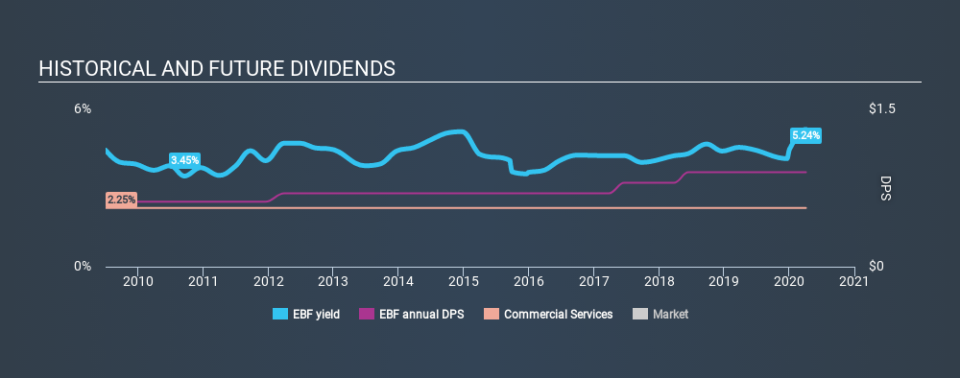There's A Lot To Like About Ennis, Inc.'s (NYSE:EBF) Upcoming US$0.23 Dividend

Some investors rely on dividends for growing their wealth, and if you're one of those dividend sleuths, you might be intrigued to know that Ennis, Inc. (NYSE:EBF) is about to go ex-dividend in just 4 days. You will need to purchase shares before the 9th of April to receive the dividend, which will be paid on the 4th of May.
Ennis's next dividend payment will be US$0.23 per share, on the back of last year when the company paid a total of US$0.90 to shareholders. Based on the last year's worth of payments, Ennis has a trailing yield of 5.2% on the current stock price of $17.19. We love seeing companies pay a dividend, but it's also important to be sure that laying the golden eggs isn't going to kill our golden goose! As a result, readers should always check whether Ennis has been able to grow its dividends, or if the dividend might be cut.
Check out our latest analysis for Ennis
If a company pays out more in dividends than it earned, then the dividend might become unsustainable - hardly an ideal situation. Ennis paid out more than half (62%) of its earnings last year, which is a regular payout ratio for most companies. Yet cash flow is typically more important than profit for assessing dividend sustainability, so we should always check if the company generated enough cash to afford its dividend. Thankfully its dividend payments took up just 42% of the free cash flow it generated, which is a comfortable payout ratio.
It's positive to see that Ennis's dividend is covered by both profits and cash flow, since this is generally a sign that the dividend is sustainable, and a lower payout ratio usually suggests a greater margin of safety before the dividend gets cut.
Click here to see how much of its profit Ennis paid out over the last 12 months.
Have Earnings And Dividends Been Growing?
Companies with consistently growing earnings per share generally make the best dividend stocks, as they usually find it easier to grow dividends per share. Investors love dividends, so if earnings fall and the dividend is reduced, expect a stock to be sold off heavily at the same time. That's why it's comforting to see Ennis's earnings have been skyrocketing, up 24% per annum for the past five years. Management appears to be striking a nice balance between reinvesting for growth and paying dividends to shareholders. With a reasonable payout ratio, profits being reinvested, and some earnings growth, Ennis could have strong prospects for future increases to the dividend.
The main way most investors will assess a company's dividend prospects is by checking the historical rate of dividend growth. In the last ten years, Ennis has lifted its dividend by approximately 3.8% a year on average. It's good to see both earnings and the dividend have improved - although the former has been rising much quicker than the latter, possibly due to the company reinvesting more of its profits in growth.
Final Takeaway
Has Ennis got what it takes to maintain its dividend payments? We like Ennis's growing earnings per share and the fact that - while its payout ratio is around average - it paid out a lower percentage of its cash flow. Ennis looks solid on this analysis overall, and we'd definitely consider investigating it more closely.
In light of that, while Ennis has an appealing dividend, it's worth knowing the risks involved with this stock. For example - Ennis has 1 warning sign we think you should be aware of.
We wouldn't recommend just buying the first dividend stock you see, though. Here's a list of interesting dividend stocks with a greater than 2% yield and an upcoming dividend.
If you spot an error that warrants correction, please contact the editor at editorial-team@simplywallst.com. This article by Simply Wall St is general in nature. It does not constitute a recommendation to buy or sell any stock, and does not take account of your objectives, or your financial situation. Simply Wall St has no position in the stocks mentioned.
We aim to bring you long-term focused research analysis driven by fundamental data. Note that our analysis may not factor in the latest price-sensitive company announcements or qualitative material. Thank you for reading.


